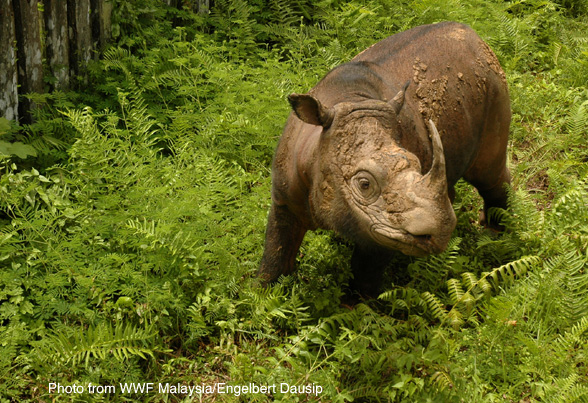Story by RHISHJA LARSON
Published on www.ecolocalizer.com, August 18th, 2009

An initiative to transport lone Borneo rhinos to a secure central location – where they can interact with other rhinos – could mean hope for this extremely rare subspecies.
Tabin Wildlife Reserve located in Sabah, Malaysia is the last home of the Bornean rhino (Dicerorhinus sumatrensis harrissoni), a distinct subspecies of the Sumatran rhino (Dicerorhinus sumatrensis sumatrensis). It is estimated that fewer than 50 Bornean rhinos are still surviving in Sabah. Borneo rhinos are said to be even smaller than Sumatran rhinos, with some standing only three feet tall at the shoulder. Both species are covered with bristly hair that rubs down as they mature and create “tunnels” by crashing through the rainforest.
Sadly, some of these rhinos are living alone in fragmented pockets of forest, cut off from other rhino populations, where they have no hope of meeting another of their kind – and the isolation of these animals could lead to their extinction.
In a recent article in the Star (Malaysia), Junaidi Payne of WWF and Borneo Rhinoceros Alliance (Bora) says that these rhinos are likely to die out completely unless there is some active intervention.
In the past, rhinos were threatened by poaching, loss of habitat and so on. But now they are mostly threatened by the simple fact that there just aren’t enough of them around in one place anymore. Tabin is the only place left in Malaysia where there is hope of saving the rhino because there are a few breeding individuals and we know the habitat is good because historically they were here.
An intervention to save Borneo rhinos
Fortunately, some human intervention has arrived: Plans have been approved to create the 4,500ha Borneo Rhinoceros Sanctuary (BRS) within Tabin Wildlife Reserve. Individual rhinos will be brought in from their fragmented locations in hopes that roaming free together in the sanctuary will entice them to breed.
The Borneo Rhinoceros Sanctuary (BRS) is new hope for these small rhinos. The plan is not to round up every wild rhino in Sabah, but rather to locate the isolated rhinos and transport them to a central location where they can roam and interact naturally with other rhinos in the sanctuary.
This will be a “hands-off” breeding program, in contrast to a failed captive breeding program in Malaysia in which tragically, most of the rhinos died. By translocating these rhinos to the BRS, they are given a chance to contribute to the survival of the species – something they certainly cannot do alone.
As part of the initiative, the sanctuary will be encircled by an electric fence – the first project of its kind to include a large fenced area in a tropical rainforest.
The rhino sanctuary’s first resident
The Borneo Rhino Sanctuary even has its first resident – Tam, a male rhino found in a palm oil plantation last year. Because Tam did not want to return to the forest on his own, WWF’s Payne suspects the rhino had previously been injured by a trap set by poachers.
Tam is currently living in a fenced 2,500ha area until the sanctuary is ready. He receives regular medical check-ups from volunteers in a makeshift paddock within his temporary home.
Once the BRS is ready, Tam will be moved. The sanctuary is expected to be open in year. Wildlife experts are planning to capture four or five additional rhinos over the next few years, and introduce them to the sanctuary. It is not expected that the rhinos will begin breeding immediately, and it could be ten years before the success of the project can be determined.
Borneo rhinos in the future
The ultimate goal of the BRS is to ensure the long-term survival of these rhinos. Payne points out that without a conservation “intervention”, the Borneo rhino will become extinct in our lifetime.
The BRS is a joint initiative between the Sime Darby Foundation and the Sabah Government. The project is part of Sime’s Big 9 campaign to protect nine endangered Malaysian animals – the Sumatran rhino, orang utan, hornbill, sun bear, banteng (wild cattle), clouded leopard, pygmy elephant, proboscis monkey and the Malayan tiger, all of which (with the exception of the tiger) can be found in Tabin.
Here’s to the future success of the Borneo Rhinoceros Sanctuary!